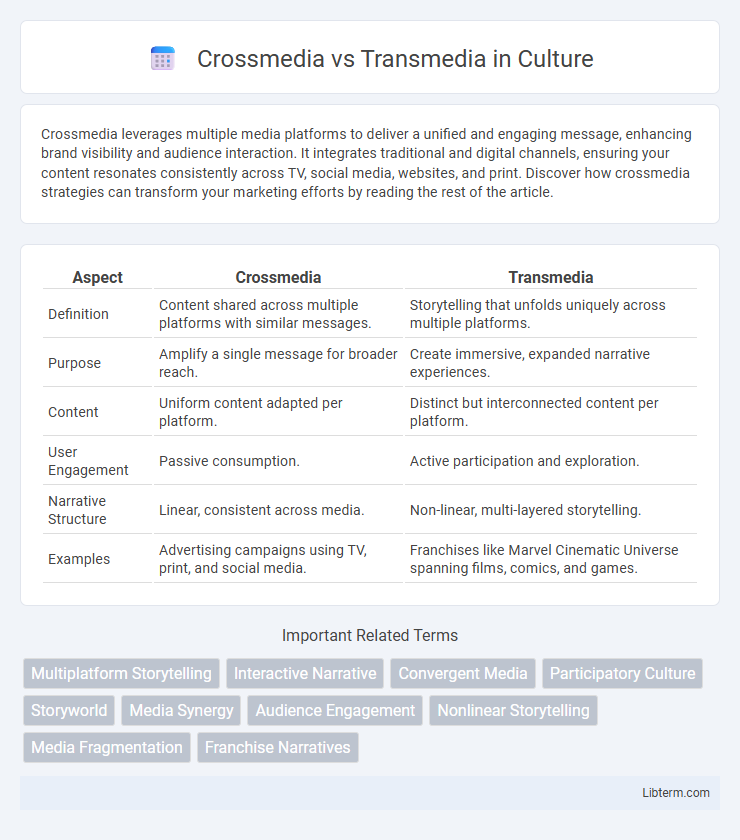Crossmedia leverages multiple media platforms to deliver a unified and engaging message, enhancing brand visibility and audience interaction. It integrates traditional and digital channels, ensuring your content resonates consistently across TV, social media, websites, and print. Discover how crossmedia strategies can transform your marketing efforts by reading the rest of the article.
Table of Comparison
| Aspect | Crossmedia | Transmedia |
|---|---|---|
| Definition | Content shared across multiple platforms with similar messages. | Storytelling that unfolds uniquely across multiple platforms. |
| Purpose | Amplify a single message for broader reach. | Create immersive, expanded narrative experiences. |
| Content | Uniform content adapted per platform. | Distinct but interconnected content per platform. |
| User Engagement | Passive consumption. | Active participation and exploration. |
| Narrative Structure | Linear, consistent across media. | Non-linear, multi-layered storytelling. |
| Examples | Advertising campaigns using TV, print, and social media. | Franchises like Marvel Cinematic Universe spanning films, comics, and games. |
Understanding Crossmedia: Definition and Core Concepts
Crossmedia refers to the use of multiple media platforms to deliver complementary content that reinforces a single central message or campaign, ensuring audience engagement through consistent storytelling. Core concepts of crossmedia include coherence, synergy, and targeted distribution across channels such as print, digital, and broadcast to maximize reach and impact. This approach differs from transmedia, which expands a narrative across platforms with each medium offering unique, independent content that collectively enhances the overall story experience.
What is Transmedia? An In-Depth Overview
Transmedia storytelling involves creating a unified and coordinated narrative experience across multiple platforms, such as films, books, games, and social media, each contributing unique content to expand the story world. It differs from crossmedia, which simply adapts the same content for different media without significantly extending the narrative. By leveraging diverse media channels with complementary story elements, transmedia engages audiences more deeply and encourages active participation in the story.
Key Differences Between Crossmedia and Transmedia
Crossmedia utilizes multiple platforms to share a singular narrative, adapting content to each medium without expanding the story world. Transmedia storytelling develops a cohesive narrative universe where each platform contributes unique story elements, enriching the overall experience. The primary difference lies in transmedia's emphasis on narrative depth across channels, whereas crossmedia focuses on distribution and format adaptation.
Historical Evolution of Media Integration Strategies
Crossmedia and transmedia strategies have evolved distinctly since early 20th-century media experiments; crossmedia initially involved adapting a single narrative across multiple platforms to maximize audience reach, while transmedia developed to create expansive, interconnected stories that unfold uniquely across each medium. Landmark shifts occurred with digital technology advancements in the 1990s, enabling immersive transmedia storytelling exemplified by franchises like The Matrix, which integrated films, comics, and games into a cohesive narrative universe. This historical evolution reflects a broader trend from simple content replication toward complex narrative ecosystems designed to engage audiences interactively across diverse channels.
How Crossmedia Enhances Audience Engagement
Crossmedia enhances audience engagement by delivering a consistent message across multiple platforms, allowing users to interact with content in different formats such as video, social media, and print. This approach increases touchpoints, making audience participation more frequent and immersive. By tailoring each platform's content to its unique strengths, Crossmedia creates a cohesive brand experience that sustains interest and encourages active involvement.
Transmedia Storytelling: Building Immersive Worlds
Transmedia storytelling creates immersive worlds by distributing a unified narrative across multiple platforms, such as books, films, games, and social media, allowing audiences to engage interactively and deepen their connection to the story. Unlike crossmedia, which adapts the same content for different media, transmedia expands the narrative universe with unique, complementary story elements tailored to each medium's strengths. This approach enhances audience immersion and participation, driving stronger emotional engagement and brand loyalty through a layered, multi-platform experience.
Examples of Successful Crossmedia Campaigns
Crossmedia campaigns effectively leverage multiple platforms like TV, social media, and print to deliver a coherent brand message, exemplified by Coca-Cola's "Share a Coke" campaign, which combined personalized bottles with digital and outdoor advertising. Another notable example is Nike's "Just Do It" campaign that integrated TV commercials, social media challenges, and retail experiences to engage consumers across channels. These campaigns demonstrate how synchronized storytelling across diverse media maximizes audience reach and brand impact.
Notable Transmedia Projects in Popular Culture
Notable transmedia projects like the Marvel Cinematic Universe and the Star Wars franchise exemplify storytelling across multiple platforms, including films, television series, comics, novels, and video games, creating immersive narrative experiences. These projects integrate diverse media channels to expand the storyline and engage audiences in multifaceted ways, distinguishing them from crossmedia efforts that primarily repurpose content across formats. Transmedia storytelling leverages character development, world-building, and plot extensions customized for each medium, enhancing fan interaction and franchise longevity.
Choosing the Right Strategy: Crossmedia or Transmedia?
Choosing the right strategy between crossmedia and transmedia depends on the project's goals and audience engagement level. Crossmedia involves distributing similar content across multiple platforms to maximize reach, ideal for brand consistency and broad exposure. Transmedia storytelling creates unique, complementary narratives on each platform, enhancing immersive user experiences and deeper emotional connections.
Future Trends in Crossmedia and Transmedia Narratives
Crossmedia narratives distribute content across multiple platforms with each medium conveying a distinct part of the story, while transmedia storytelling integrates these platforms into a unified narrative experience where each medium contributes uniquely to the whole storyworld. Future trends in crossmedia focus on immersive, interactive technologies such as augmented reality (AR) and virtual reality (VR) to deepen audience engagement and personalize content delivery across devices. Transmedia storytelling is evolving towards AI-driven adaptive narratives that respond to user choices, enhancing interactivity and expanding narrative complexity across interconnected digital ecosystems.
Crossmedia Infographic

 libterm.com
libterm.com